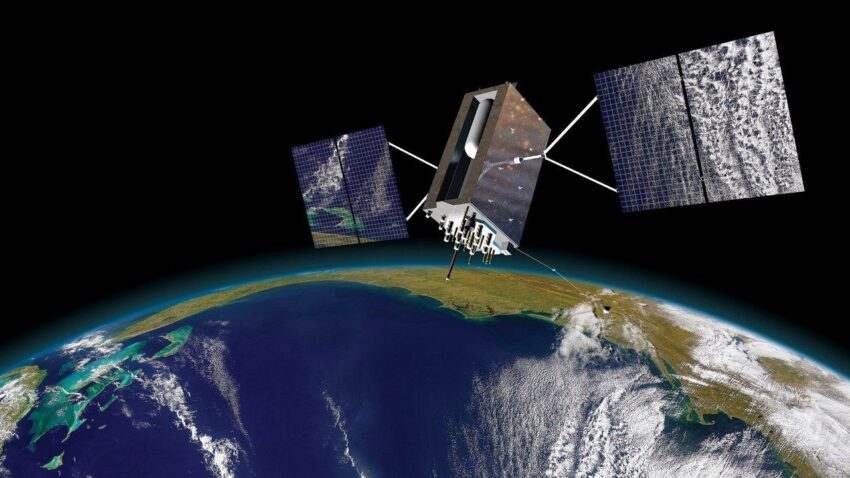GPS III satellite, (Lockheed Martin image)
WASHINGTON — The Space Force has taken delivery from RTX of the first two command and control (C2) software blocks newest model GPS satellites — but the long-delayed, multi-billion dollar Next-Generation Operational Control System (OCX) system is not yet out of the woods.
OCX is needed to provide full C2 of the GPS III satellites, as well as to allow some 700 weapon systems across the US military to fully access the encrypted M-Code signal. The Space Force in May launched the eighth of 10 planned GPS III satellites, but they are using an interim C2 software designed by satellite maker Lockheed Martin. The last two birds are expected to launch by the end of this year, before OCX is operational.
In response to questions from Breaking Defense, a spokesperson for Space Operations Command (SpOC) explained that government-led testing of OCX now will commence, but that an updated operational acceptance date “is not yet available.”
“On 1 July 2025 the DD250 [delivery approval form] was submitted for OCX Block 1 and 2, signaling the end of major development and contractor-led test. Mission Delta 31 is now in the OCX transition Campaign, or the ‘Readiness To Transition to Operations’ phase,” the spokesperson said Wednesday in an email. “The last two major milestones in the campaign are Constellation Transfer and Operational Acceptance. MD 31 is continuing government-led testing, operational readiness exercises, and preparing for the GPS constellation transfer.”
In a familiar pattern of service expectations for progress being dashed, the Space Force just last October expressed confidence that government-led testing would begin at the end of 2024 — a date that already was a delay from plans in in 2023.
OCX has been a poster child for broken space acquisition programs. According to a June report from the Government Accountability Office, OCX is about 12 years behind its originally planned schedule and slightly more than $3 billion over budget with a projected price tag of $10 billion. The report noted that Space Force program officials as of January were expecting operational acceptance in the third quarter of 2026, but given the latest delay in delivery of Block 1 and 2, it is likely that that date has also slipped.
Further, GAO reported that RTX (formerly Raytheon) would need to continue to address software deficiencies even after delivery of OCX Block 1 and 2.
“November 2024, DOD announced a $196.7 million modification to Raytheon’s OCX development contract. According to program officials, the modification will support testing of OCX Blocks 1 and 2 after delivery to operations, as well as address remaining deficiencies.”
The congressional watchdog office found that as of December 2024, OCX faced “102 open deficiencies
related to site acceptance testing requirements, 39 related to simulators and testing systems, and 129 directly related to developmental testing.”
And according to the GAO report, RTX’s troubles with OCX Block 1 and 2 have caused delays to the next iteration of the software, called OCX 3F, “due to the extended diversion of Raytheon personnel” — in turn threatening delay to the planned operation of the newest model GPS IIIF satellites.
Under the $9 billion GPS IIIF program, Lockheed Martin will produce up to 22 birds. The GPS IIIF models will provide new capabilities, according to the GAO report, including “a steerable, high-power [M-code] signal — known as Regional Military Protection — to provide warfighters with greater jamming resistance in contested environments.”
As of December 2024, OCX Block 3F is “undergoing a schedule rebaseline due to contractor Raytheon’s projected delays to the program’s final acquisition milestone—the predelivery integrated testing,” the GAO report said.
“The OCX Block 3F program reported that the first of the program’s planned capability deliveries — the launch and check-out capability for GPS IIIF satellites — is projected to be delivered in January 2025. Delays to the OCX Block 3F program could have corresponding effects on the Space Force’s ability to launch and operate GPS IIIF satellites,” GAO found.
The first GPS III satellite originally was projected to be ready for launch next April, but according to GAO, has been already delayed until November 2026.
However, OCX isn’t the main culprit for that seven month delay, the report explained. Instead, the program has experienced technical problems with the satellite’s mission data unit (MDU), what GAO called “the brain of the satellite’s navigation mission.” The MDUs are being developed and manufactured by subcontractor L3Harris.
Click this link for the original source of this article.
Author: Theresa Hitchens
This content is courtesy of, and owned and copyrighted by, https://breakingdefense.com and its author. This content is made available by use of the public RSS feed offered by the host site and is used for educational purposes only. If you are the author or represent the host site and would like this content removed now and in the future, please contact USSANews.com using the email address in the Contact page found in the website menu.








